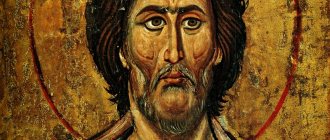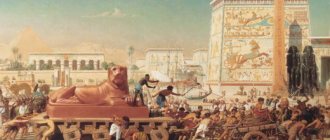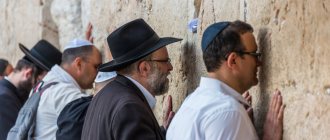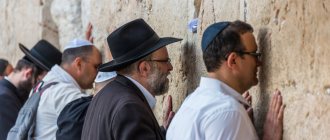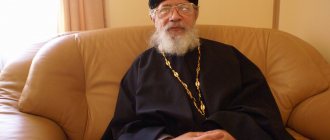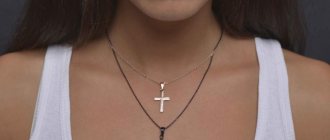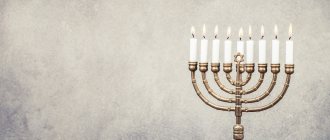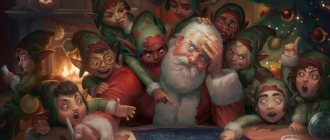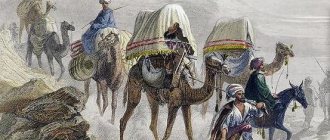There were and are a huge number of crosses in the world: the ancient Egyptian Ankh, Celtic cross, solar, Latin, Orthodox, Byzantine, Armenian (“blooming”), St. Andrew’s and other crosses - these are all geometric symbols used in different eras to express different meanings. Most crosses are somehow connected with Christianity.
In the Christian tradition, the veneration of the cross originates from the legend of the martyrdom of Jesus Christ. Execution by crucifixion existed before Christ - this is how robbers were usually crucified - however, in Christianity, the cross takes on the meaning not only of an instrument of execution, but of the salvation of Christians through the death of Jesus.
Varieties of Christian crosses
In the early Christian Eastern Church, about 16 types of crosses were common. Each of the crosses is revered by the church, and, as the priests say, a cross of any shape is as holy as the tree on which Jesus was crucified.
The most common types of crosses:
- Six-pointed Orthodox cross
- Eight-pointed Orthodox
- Four-pointed Latin (or Catholic)
What is the difference between these crosses?
[edit] Path
Coming out of Rameses, the Israelites arrived at Succoth, then moved to Etham, then to Pi-Hahiroth, then to Marah, then to Elin, crossed the Red Sea, ended up in the desert of Sin, their next camps were Dafka, Apush, Rephidim, the Sinai desert, Kibrot -Gattaava, Asiroth, Rhyme, Rimnon-Perez, Libna, Rissa, Kegelath, Mount Shafer, Harada, Makeloth, Tahaf, Tarah, Mythka, Hashmona, Moseroth, Bene-Jaakan, Hor-Hagidgad, Jotvatha, Avron, Ezion-geber, Kadesh, Mount Hor, Salmon, Punon, Oboth, Im-Abarim, Divo-Gad, Almon-Divlathaim, Abarim and Moab.
Six-pointed cross
This is a cross with one horizontal crossbar and a lower inclined one.
This form of the cross exists in Orthodoxy along with the eight-pointed one, being, in fact, its simplified form. The lower crossbar of the six-pointed cross symbolizes the footrest, a detail that took place in reality.
The cross on which Christ was crucified was four-pointed. Another crossbar at the feet was attached to the cross before placing the cross in a vertical position, after the crucifixion, when the place on the cross where the feet of the crucified person were located became obvious.
The inclination of the lower crossbar has the symbolic meaning of “the measure of righteousness.” The higher part of the crossbar is located on the right side. At the right hand of Christ, according to legend, a repentant and therefore justified thief was crucified. On the left side, where the crossbar faces down, a robber was crucified, who by blaspheming Jesus further aggravated his situation. In a broad sense, this crossbar is interpreted as a symbol of a person’s state of mind.
Mount Sinai. Commandments
The people of Israel continued on their way and stopped at Mount Sinai. It was already the third month of his wanderings. God sent Moses to the top of the mountain and told His people to prepare to meet Him, to be clean and to wash their clothes. On the third day there was lightning and thunder, and there was a loud sound of a trumpet. Moses and the people received the Ten Commandments from the mouth of God, and now they had to live by them.
- First: serve the One True God, who brought you out of the land of Egypt.
- Second: do not create an idol for yourself.
- Third: do not take the name of the Lord in vain.
- Fourth: do not work on the Sabbath, but glorify the name of the Lord.
- Fifth: honor your parents so that you may feel good and your days on earth will be extended.
- Six: Don't kill.
- Seventh Commandment: Thou shalt not commit adultery.
- Eighth: don't steal.
- Ninth: do not bear false witness against your neighbor.
- Tenth: You shall not covet anything near your neighbor, neither his house, nor his wife, nor his field, nor his male servant, nor his manservant, nor his ox, nor his donkey.
The Lord called Moses to Mount Sinai and talked with him for a long time; after the end of the conversation, he gave him two stone tablets with the commandments. Moses spent forty days on the mountain, and God taught him how to correctly follow His instructions, how to build a camp tabernacle and serve his God in it.
Eight-pointed cross
The eight-pointed cross is a more complete form of the Orthodox cross.
The upper crossbar, which distinguishes the cross from the six-pointed one, symbolizes the tablet with the inscription (title), which was nailed to the cross also after the crucifixion, by order of Pontius Pilate, the Roman prefect of Judea. Partly in mockery, partly to indicate the “guilt” of the crucified man, the tablet read in three languages: “Jesus of Nazareth, King of the Jews” (I.N.C.I.).
Thus, the meaning of the six-pointed and eight-pointed crosses is the same, but the eight-pointed cross is more rich in symbolic content.
Sources and links
| Exodus from Egypt on Wikimedia Commons? |
- KEE, volume 3, col. 945–954
- KEE, volume 3, col. 62–218
- I'm Isaacs. "Our people." Exodus from Egypt
- J. Sachs. Torah lessons. “One or many outcomes?” Concept of Exodus in Hasidism
- Physicists have confirmed the accuracy of historical dating of the Egyptian kingdoms
- The computer showed why the Red Sea parted. BBC Russian
- Carl Drews, Weiqing Han. Dynamics of Wind Setdown at Suez and the Eastern Nile Delta. PLoS One
- New Dates for Egypt's Pharaohs - ScienceNOW, 06/17/2010
- Articles about the Exodus on the Mahanaim website
Notice
: The preliminary basis of this article was the article Exodus in the EEE
Notice
: The preliminary basis of this article was the article Land of Israel (Eretz Yisrael). Historical sketch in EEE
Eight-pointed cross-Golgotha
The most complete type of Orthodox cross is the Golgotha cross. This symbol contains many details that reflect the meaning of Orthodox doctrine.
The eight-pointed cross stands on a symbolic image of Mount Golgotha, on which, as it is written in the Gospel, the crucifixion of Christ took place. To the left and right of the mountain are the letter signatures of G.G. (Mount Golgotha) and M.L. R.B. (Place of Execution Crucified Byst or, according to another version, Place of Execution Paradise Byst - according to legend, at the site of the execution of Christ there was once Paradise and the forefather of humanity, Adam, was buried here).
Under the mountain there is a skull and bones - this is a symbolic image of the remains of Adam. Christ “washed” his bones with his blood, saving humanity from original sin. The bones are arranged in the order in which the hands are folded during communion or burial, and the letters G.A. located near the skull indicate the words Head of Adam.
To the left and right of the cross are depicted the instruments of Christ’s execution: on the left is a spear, on the right is a sponge with the corresponding letter signatures (K. and G.). According to the Gospel, a warrior brought a sponge on a cane, soaked in vinegar, to Christ’s lips, and another warrior pierced his ribs with a spear.
Behind the cross there is usually a circle - this is the crown of thorns of Christ.
On the sides of the cross of Golgotha there are inscriptions: Isa. Xs. (short form of Jesus Christ), King of Glory, and Ni Ka (meaning Conqueror).
As you can see, the Golgotha cross is the most complete form of the Orthodox Christian cross in terms of symbolic content.
Exodus Thematic Dictionary:
- see {C} in Exodus 12:33
- flight of the Israelites from Egypt
- {T}FREEDOM as the theme of Exodus => Exodus 6:6
- - went to Egypt => Gen 46:1-27
- 1. God's choice of deliverer - Moses was preserved after birth => Exodus 2:1-10
- - signs given to Moses => Exodus 4:1-9
- - faithfulness to His promises => Gen 15:13-16
- - solemn song after crossing the Red Sea => Exodus 15:1-21
- - salvation in Christ => 1 Cor 10:1-4
Four-pointed cross
The four-pointed cross is one of the most ancient variants of Christian symbolism. The cross of the Armenian Church, in which Christianity was recognized as the state religion for the first time in the world at the beginning of the 4th century AD, was and remains four-pointed.
In addition, crosses not only on ancient, but also on the most famous Orthodox cathedrals have a four-pointed shape. For example, at the Cathedral of Hagia Sophia in Constantinople, the Assumption Cathedral in Vladimir, the Transfiguration Cathedral in Pereslavl, and the Peter and Paul Orthodox Church in St. Petersburg.
You can also find crosses with a crescent. The crescent on the cross, according to different versions, symbolizes the anchor (the Church as a place of salvation), the Eucharistic Chalice, the cradle of Christ or the baptismal font.
However, if in Orthodox churches the four-pointed form of the cross is not often found, then in the Catholic Church only one version of the cross is used - the four-pointed one, otherwise called the Latin cross.
Chapter V. The Calling of Moses and the Exodus of the Jews from Egypt
Ref. 2–4
A married couple from the tribe of Levi, Abram and Jochebed, had a child. He was very handsome and brought joy to his parents. But, unfortunately, it was a boy doomed to death in the waters of the Nile. The mother fell into great despair and, despite the threat of severe punishment, decided to hide her son from the Egyptian executioners. The mother hid her child for three months, and when it became impossible to do this any longer, she tarred the basket, put her child in it and placed it in the reeds near the river bank. The mother went home, and Mariam instructed her daughter to hide on the shore and watch what would happen to the baby.
The one whom the Lord destined to save the Jewish people could not die in the waters of the Nile. At this time, the daughter of the pharaoh came to bathe in the sacred river. Seeing a basket in the reeds and hearing the cry of a child, she ordered her slave to get it out of the water. Imagine the princess’s surprise when a basket with a crying baby was placed at her feet! She gently bent over the foundling and caressed him, trying to calm him down.
The Pharaoh's daughter immediately guessed that she had found an Israeli child, and since in the depths of her soul she condemned her father's inhumane order, she decided to take the child under her protection. Mariam, who had been watching this scene from afar, approached the Pharaoh’s daughter, offering to find a Jewish nurse for this child. Having received consent, she joyfully rushed home to fetch her mother. Thus, by the providence of God, the child returned safely to the arms of his dear parent. He was no longer in danger of death in the depths of the Nile, since none of the Egyptian executioners dared to contradict the wishes of the pharaoh’s daughter. A few years later, when the boy had already grown up, his mother took him to the palace, and the Pharaoh’s daughter adopted the little Israeli, calling him Moses, which means “taken from the water.”
The biblical narrative gives no details of Moses' early life at Pharaoh's court. It is only known that he was “taught... in all the wisdom of Egypt” (Acts 7:22), i.e. received the highest education that was available to the priests and ruling classes of the country, who kept all scientific and high religious knowledge secret from the people. But, having accepted all the good that the Egyptian culture had in itself, Moses at the same time kept his mind and heart pure from gross idolatry and, with God’s help, was established in the faith of his fathers (Acts 7). As the son of a royal daughter, he was destined for a brilliant career at court. But, living in the circle of the royal family, he never forgot that he was a Jew, and with all his soul he loved his numerous people. Often before his eyes a picture of the life of his brothers arose, he saw how they suffered, how they cursed their fate, heard the whistle of whips driving them to slave labor, he heard their complaints, sobs and pleas for salvation.
One day, having come to his blood brothers, Moses saw how the Egyptian overseer mercilessly mocked an Israelite, who, probably due to weakness of strength, could not do what he was ordered. Moses stood up for his fellow tribesman and, seeing that there was no one around, killed the cruel tormentor and buried the body in the sand. The day after the murder, he witnessed a fight between two Israelis. Moses separated the angry opponents and asked the stronger one: “Why do you beat your neighbor?” (Ex. 2:13). The Jew did not like Moses’ intervention and defiantly said to him: “Who made you a leader and a judge over us? “Are you thinking of killing me like you killed... the Egyptian?” (Ex. 2:14). These words made Moses’ heart tremble; he realized that if many already knew about the murder of the Egyptian, then the spies would not hesitate to report it to Pharaoh. And indeed, good people soon warned Moses that Pharaoh had ordered the palace guards to seize him and put him to death. Fleeing from the persecution of the guards, Moses secretly leaves the capital, and then the country, and takes refuge in the desert on the Sinai Peninsula.
Moving further and further east from Egypt, Moses found himself in a land inhabited by the Midian tribe. Tired from the long journey, he sat down at the well to rest and began to watch with curiosity as seven shepherd girls watered the sheep. But then a band of shepherds approached the well; they roughly pushed the girls away and began to water their cattle. Outraged by the act of the shepherds, Moses stood up and, despite his fatigue, swung menacingly at them. The insolent people got scared and left. Moses helped the girls water the sheep, and they returned home safely. It turned out that the shepherdesses were the daughters of a Midian priest named Jethro. The grateful father invited Moses to his home, and when he learned that the stranger, among other things, was distantly related to him, he accepted him into the bosom of his family and married him to his daughter Zipporah, from whom two sons were born: Gersam and Eliezer. Moses helped his father-in-law with housework and tended his cattle.
The sin of the prophet Moses
Moses himself was not destined to enter the Promised Land. Together with his brother the high priest Aaron, he angered the Lord. This unfortunate incident occurred in Kadesh, where the Jews' journey led them. Experiencing the pangs of thirst, they once again grumbled. To give them something to drink, the Lord, wanting to repeat the miracle He had once performed, commanded Moses to command the rock to flow with life-giving moisture.
But this time, His hitherto faithful servant doubted the omnipotence of God and, not limiting himself to words, hit the rock twice with his staff. The water, of course, flowed and quenched the thirst of the suffering. But the lack of faith shown that day by Moses and his brother Aaron brought upon them the wrath of God, as a result of which the Promised Land was closed to them forever, and the Jewish people entered it without their leader.
Moses' walk in the desert ended at the very border of the earth, to which he had been striving for forty years. The Lord took him to the top of the Abarim mountain range and from there showed him the whole country that He had prepared for his people. Having surveyed it from end to end, Moses died. The Lord hid from descendants the burial place of one of His greatest prophets, making it unknown to this day.
Miracles Revealed in the Desert
But, in addition to moral support, He provided them with practical help, working miracles through His servant Moses. This is exactly what happened when, by God's permission, the prophet delivered his fellow tribesmen from the torment of thirst, turning the bitter dead water into clean and drinkable water. The same thing happened again when their food supply ran out, and the Lord sent them countless flocks of quails. In addition, for as many years as Moses led the Jews through the desert, for so many years He rained down sweet manna on them from heaven, which became their daily food. It even acquired the character of a catchphrase - “manna from heaven”, used in cases when we are talking about some unexpected luck.
Undoubted evidence of God's protection to the people brought out of Egypt are the miracles of Moses in the desert, and, in particular, those performed by him at one of their camps, called Rephidim. At first, according to the Bible, Moses delivered his fellow tribesmen from thirst for the second time, this time with a blow of his rod, drawing water out of the rock. And soon, raising his hands to God, with fervent prayer he asked Him for victory over the treacherous Amalekites who attacked their camp.
Slavery of the Children of Israel
According to these ancient texts, Moses, the prophet and leader of the Jewish people, was born in Egypt during difficult times for his brothers. Having settled on the banks of the Nile in the years when, thanks to their compatriot Joseph, the mind managed to gain the favor of the former pharaoh, these people fell into severe disgrace under his successor, and from full citizens turned into slaves.
In relation to them, the Egyptian ruler pursued a policy that today we would rightfully call genocide. It was pointless to fight, and the only way of salvation was the exodus into the endless expanses of the Sinai desert, beyond which the Jews dreamed of the land promised by God, “flowing with milk and honey.” At this difficult moment, the Lord sent Moses, a prophet who delivered his long-suffering people from slavery.
